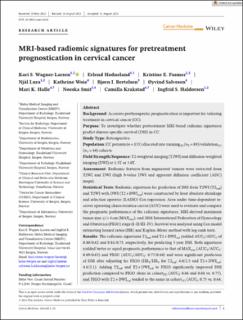| dc.contributor.author | Wagner-Larsen, Kari Strøno | |
| dc.contributor.author | Hodneland, Erlend | |
| dc.contributor.author | Fasmer, Kristine Eldevik | |
| dc.contributor.author | Lura, Njål | |
| dc.contributor.author | Woie, Kathrine | |
| dc.contributor.author | Bertelsen, Bjørn | |
| dc.contributor.author | Salvesen, Øyvind Olav | |
| dc.contributor.author | Halle, Mari Kyllesø | |
| dc.contributor.author | Smit, Noeska Natasja | |
| dc.contributor.author | Krakstad, Camilla | |
| dc.contributor.author | Haldorsen, Ingfrid S. | |
| dc.date.accessioned | 2023-11-07T16:02:41Z | |
| dc.date.available | 2023-11-07T16:02:41Z | |
| dc.date.created | 2023-10-30T13:57:19Z | |
| dc.date.issued | 2023 | |
| dc.identifier.citation | Cancer Medicine. 2023, . | en_US |
| dc.identifier.issn | 2045-7634 | |
| dc.identifier.uri | https://hdl.handle.net/11250/3101195 | |
| dc.description.abstract | Background
Accurate pretherapeutic prognostication is important for tailoring treatment in cervical cancer (CC).
Purpose
To investigate whether pretreatment MRI-based radiomic signatures predict disease-specific survival (DSS) in CC.
Study Type
Retrospective.
Population
CC patients (n = 133) allocated into training(T) (nT = 89)/validation(V) (nV = 44) cohorts.
Field Strength/Sequence
T2-weighted imaging (T2WI) and diffusion-weighted imaging (DWI) at 1.5T or 3.0T.
Assessment
Radiomic features from segmented tumors were extracted from T2WI and DWI (high b-value DWI and apparent diffusion coefficient (ADC) maps).
Statistical Tests
Radiomic signatures for prediction of DSS from T2WI (T2rad) and T2WI with DWI (T2 + DWIrad) were constructed by least absolute shrinkage and selection operator (LASSO) Cox regression. Area under time-dependent receiver operating characteristics curves (AUC) were used to evaluate and compare the prognostic performance of the radiomic signatures, MRI-derived maximum tumor size ≤/> 4 cm (MAXsize), and 2018 International Federation of Gynecology and Obstetrics (FIGO) stage (I–II/III–IV). Survival was analyzed using Cox model estimating hazard ratios (HR) and Kaplan–Meier method with log-rank tests.
Results
The radiomic signatures T2rad and T2 + DWIrad yielded AUCT/AUCV of 0.80/0.62 and 0.81/0.75, respectively, for predicting 5-year DSS. Both signatures yielded better or equal prognostic performance to that of MAXsize (AUCT/AUCV: 0.69/0.65) and FIGO (AUCT/AUCV: 0.77/0.64) and were significant predictors of DSS after adjusting for FIGO (HRT/HRV for T2rad: 4.0/2.5 and T2 + DWIrad: 4.8/2.1). Adding T2rad and T2 + DWIrad to FIGO significantly improved DSS prediction compared to FIGO alone in cohort(T) (AUCT 0.86 and 0.88 vs. 0.77), and FIGO with T2 + DWIrad tended to the same in cohort(V) (AUCV 0.75 vs. 0.64, p = 0.07). High radiomic score for T2 + DWIrad was significantly associated with reduced DSS in both cohorts. | en_US |
| dc.language.iso | eng | en_US |
| dc.publisher | Wiley | en_US |
| dc.rights | Navngivelse 4.0 Internasjonal | * |
| dc.rights.uri | http://creativecommons.org/licenses/by/4.0/deed.no | * |
| dc.title | MRI-based radiomic signatures for pretreatment prognostication in cervical cancer | en_US |
| dc.title.alternative | MRI-based radiomic signatures for pretreatment prognostication in cervical cancer | en_US |
| dc.type | Peer reviewed | en_US |
| dc.type | Journal article | en_US |
| dc.description.version | publishedVersion | en_US |
| dc.source.pagenumber | 0 | en_US |
| dc.source.journal | Cancer Medicine | en_US |
| dc.identifier.doi | 10.1002/cam4.6526 | |
| dc.identifier.cristin | 2190042 | |
| cristin.ispublished | true | |
| cristin.fulltext | original | |
| cristin.qualitycode | 1 | |

